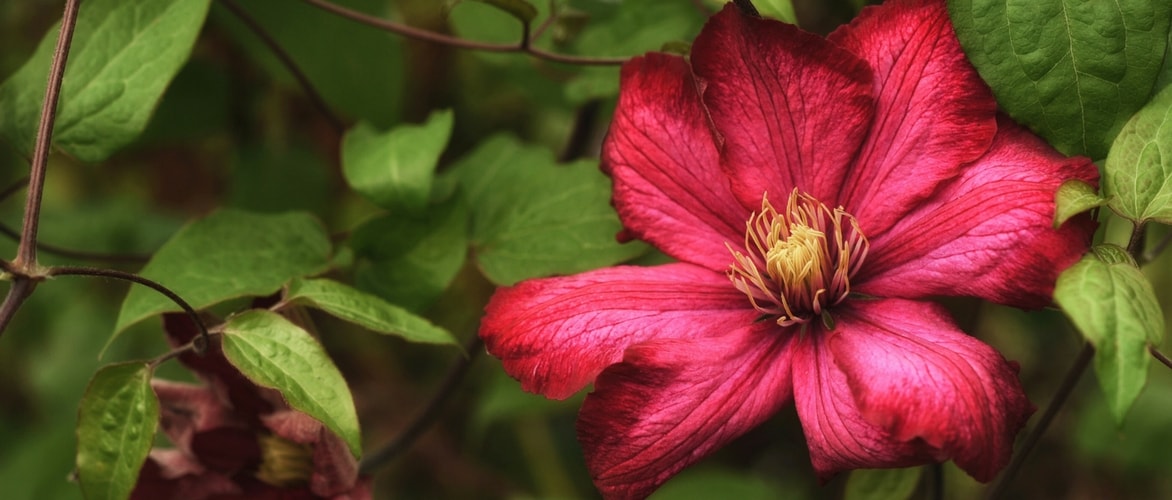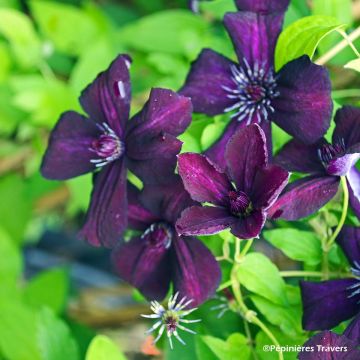

Clématite - Clematis viticella Panther
Clematis x viticella Panther
Clematis x viticella Panther
Beautiful plant that bloomed in the autumn; it is currently regrowing from the base.
MaDo, 13/03/2024
Special offer!
Receive a €20 voucher for any order over €90 (excluding delivery costs, credit notes, and plastic-free options)!
1- Add your favorite plants to your cart.
2- Once you have reached €90, confirm your order (you can even choose the delivery date!).
3- As soon as your order is shipped, you will receive an email containing your voucher code, valid for 3 months (90 days).
Your voucher is unique and can only be used once, for any order with a minimum value of €20, excluding delivery costs.
Can be combined with other current offers, non-divisible and non-refundable.
Why not try an alternative variety in stock?
View all →This plant carries a 6 months recovery warranty
More information
We guarantee the quality of our plants for a full growing cycle, and will replace at our expense any plant that fails to recover under normal climatic and planting conditions.

Would this plant suit my garden?
Set up your Plantfit profile →
Description
Clematis viticella 'Panther' has the natural robustness and long summer flowering of Italian clematis, but this variety produces larger flowers, of an intense violet colour. They bloom for several weeks from June on a robust plant that can reach up to about 3m (10ft). This hardy climber is resistant to diseases. It will be satisifed with well-worked ordinary garden soil, and will live for many years in the garden.
The genus Clematis belongs to the Ranunculaceae family. 'Panther' is a French horticultural variety from Javoy nurseries. It is a hybrid derived in particular from Clematis viticella, native to southern Europe. It is a group 3 clematis that flowers in summer on the current year's growth. It is a semi-woody and climbing perennial plant, which will reach 2.5 to 3m (8 to 10ft) in height with a spread of 1.5m² (5ft²).
From June to September, 'Panther' bears single flowers, 10 to 12cm (4 to 5in) in diameter. They appear mainly in the upper half of the vegetation. The flowers are solitary, erect, and fully open. Each one has 6 rather narrow, slightly wavy and undulate sepals, of a deep violet colour. They are open on a bouquet of yellow stamens. The light green leaves are divided into ovate to lanceolate leaflets. The deciduous foliage dries in winter. This clematis clings to the support or to the host plant through petioles transformed into tendrils.
Plant your clematis alongside climbing roses to extend the flowering period of walls and pergolas until the end of summer. It is a genus rich in diversity, with varieties available in all colours, shapes, and sizes. Take advantage of the ease of cultivation of the viticella group varieties to give your garden a romantic and bohemian touch. 'Panther' is easily grown in the garden. Choose a sunny exposure and plant it in ordinary soil. It will tolerate dry summers better than large-flowered clematis. Let it climb over a shrub with a different flowering time, such as lilac, bamboo Fargesia, or Black Tower elder with purple foliage, for example. It forms a beautiful duo with the red flowers of Clematis 'Voluceau'.
Clematis x viticella Panther in pictures


Plant habit
Flowering
Foliage
Botanical data
Clematis
x viticella
Panther
Ranunculaceae
Cultivar or hybrid
Other Clematis Viticella
View all →Planting and care
Ideally, plant in full sun, in fairly fertile, well-tilled and well-drained soil, shading the roots and base of the stem (with a flat tile, for example). Clematis from the C. viticella species are robust, less demanding in terms of soil, less temperamental than large-flowered clematis, and less susceptible to wilt disease. They also perform much better in hot and dry summers.
Work the soil to a depth of 20cm (8in), lightened with good quality compost. Plant it by covering the root ball with 3cm (1in) of soil. Cover the base of climbing clematis with a small mound of soil to reduce the risk of wilt and encourage new shoots from the stump. After planting, cut back the stems of deciduous climbing clematis to about 30cm (12in) from the base, above a pair of buds. Water regularly and generously during the first few weeks. Do not overwater, as stagnant water can lead to the development of fungus at the base of the plant.
Mulch in February with garden compost or well-rotted manure, avoiding direct contact with the stems.
Train the stems, without tightening them, until the plant can cling on its own. Clematis also enjoy growing freely on neighbouring plants.
This variety blooms on the current year's growth in summer, so prune it in March to 25cm (10in) from the ground (slightly shorter on older subjects), cutting cleanly with secateurs above two large buds. A less severe pruning will help it reach larger dimensions, but it will bloom mainly in the upper part of the vegetation.
Voles and grey worms can attack clematis and devour the stems. Aphids and greenhouse whiteflies are also potential parasites.
Planting period
Intended location
Care
Planting & care advice
-
, onOrder confirmed
Reply from on Promesse de fleurs
Similar products
Haven't found what you were looking for?
Hardiness is the lowest winter temperature a plant can endure without suffering serious damage or even dying. However, hardiness is affected by location (a sheltered area, such as a patio), protection (winter cover) and soil type (hardiness is improved by well-drained soil).

Photo Sharing Terms & Conditions
In order to encourage gardeners to interact and share their experiences, Promesse de fleurs offers various media enabling content to be uploaded onto its Site - in particular via the ‘Photo sharing’ module.
The User agrees to refrain from:
- Posting any content that is illegal, prejudicial, insulting, racist, inciteful to hatred, revisionist, contrary to public decency, that infringes on privacy or on the privacy rights of third parties, in particular the publicity rights of persons and goods, intellectual property rights, or the right to privacy.
- Submitting content on behalf of a third party;
- Impersonate the identity of a third party and/or publish any personal information about a third party;
In general, the User undertakes to refrain from any unethical behaviour.
All Content (in particular text, comments, files, images, photos, videos, creative works, etc.), which may be subject to property or intellectual property rights, image or other private rights, shall remain the property of the User, subject to the limited rights granted by the terms of the licence granted by Promesse de fleurs as stated below. Users are at liberty to publish or not to publish such Content on the Site, notably via the ‘Photo Sharing’ facility, and accept that this Content shall be made public and freely accessible, notably on the Internet.
Users further acknowledge, undertake to have ,and guarantee that they hold all necessary rights and permissions to publish such material on the Site, in particular with regard to the legislation in force pertaining to any privacy, property, intellectual property, image, or contractual rights, or rights of any other nature. By publishing such Content on the Site, Users acknowledge accepting full liability as publishers of the Content within the meaning of the law, and grant Promesse de fleurs, free of charge, an inclusive, worldwide licence for the said Content for the entire duration of its publication, including all reproduction, representation, up/downloading, displaying, performing, transmission, and storage rights.
Users also grant permission for their name to be linked to the Content and accept that this link may not always be made available.
By engaging in posting material, Users consent to their Content becoming automatically accessible on the Internet, in particular on other sites and/or blogs and/or web pages of the Promesse de fleurs site, including in particular social pages and the Promesse de fleurs catalogue.
Users may secure the removal of entrusted content free of charge by issuing a simple request via our contact form.
The flowering period indicated on our website applies to countries and regions located in USDA zone 8 (France, the United Kingdom, Ireland, the Netherlands, etc.)
It will vary according to where you live:
- In zones 9 to 10 (Italy, Spain, Greece, etc.), flowering will occur about 2 to 4 weeks earlier.
- In zones 6 to 7 (Germany, Poland, Slovenia, and lower mountainous regions), flowering will be delayed by 2 to 3 weeks.
- In zone 5 (Central Europe, Scandinavia), blooming will be delayed by 3 to 5 weeks.
In temperate climates, pruning of spring-flowering shrubs (forsythia, spireas, etc.) should be done just after flowering.
Pruning of summer-flowering shrubs (Indian Lilac, Perovskia, etc.) can be done in winter or spring.
In cold regions as well as with frost-sensitive plants, avoid pruning too early when severe frosts may still occur.
The planting period indicated on our website applies to countries and regions located in USDA zone 8 (France, United Kingdom, Ireland, Netherlands).
It will vary according to where you live:
- In Mediterranean zones (Marseille, Madrid, Milan, etc.), autumn and winter are the best planting periods.
- In continental zones (Strasbourg, Munich, Vienna, etc.), delay planting by 2 to 3 weeks in spring and bring it forward by 2 to 4 weeks in autumn.
- In mountainous regions (the Alps, Pyrenees, Carpathians, etc.), it is best to plant in late spring (May-June) or late summer (August-September).
The harvesting period indicated on our website applies to countries and regions in USDA zone 8 (France, England, Ireland, the Netherlands).
In colder areas (Scandinavia, Poland, Austria...) fruit and vegetable harvests are likely to be delayed by 3-4 weeks.
In warmer areas (Italy, Spain, Greece, etc.), harvesting will probably take place earlier, depending on weather conditions.
The sowing periods indicated on our website apply to countries and regions within USDA Zone 8 (France, UK, Ireland, Netherlands).
In colder areas (Scandinavia, Poland, Austria...), delay any outdoor sowing by 3-4 weeks, or sow under glass.
In warmer climes (Italy, Spain, Greece, etc.), bring outdoor sowing forward by a few weeks.


































































